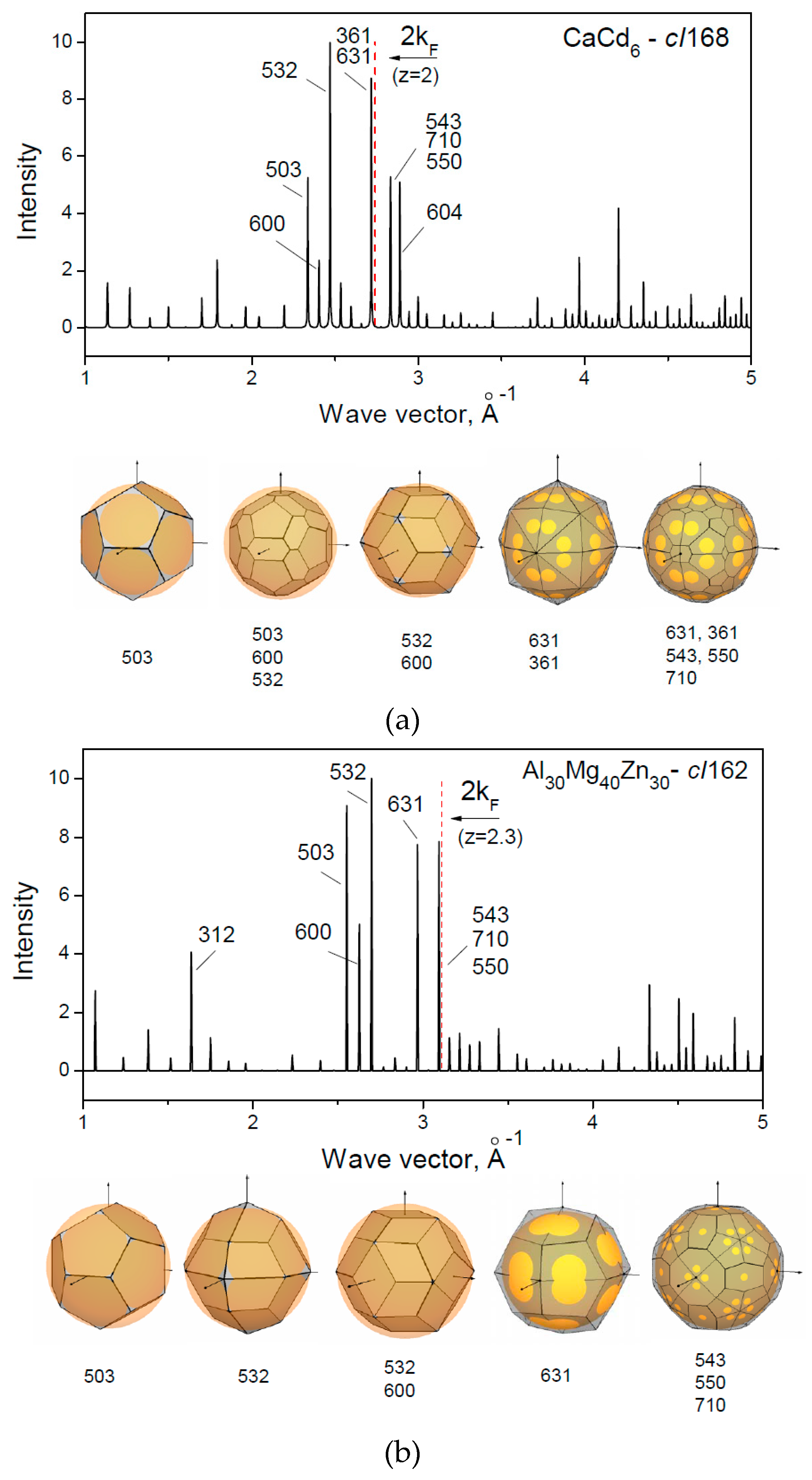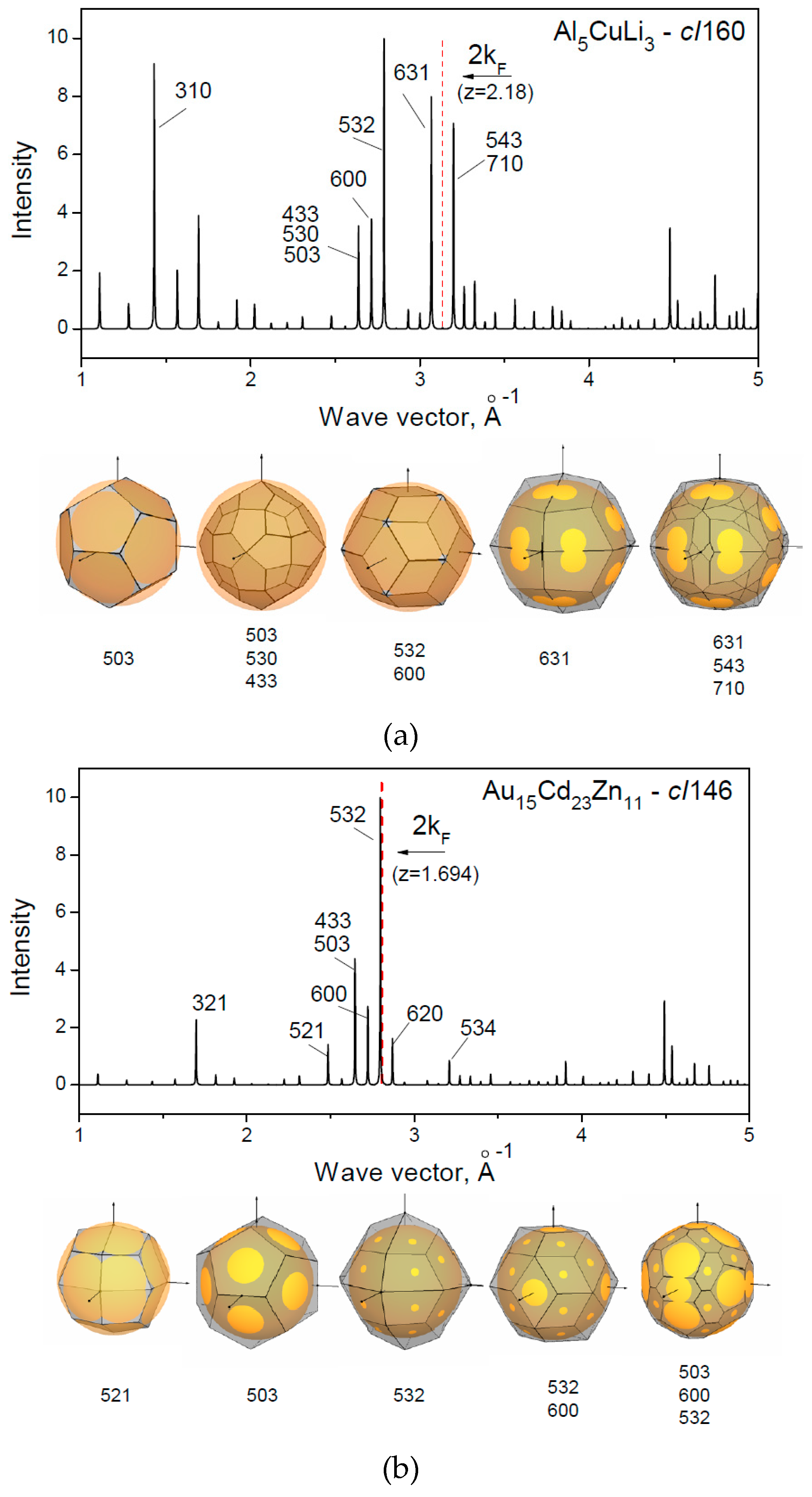Structurally Complex Frank–Kasper Phases and Quasicrystal Approximants: Electronic Origin of Stability
Abstract
:1. Introduction
2. Theoretical Background and Method of Analysis
3. Results and Discussion
3.1. Giant Unit Cell Compounds Cu4Cd3 and Mg2Al3
3.2. Quasicrystal Approximants
3.2.1. Approximants cI168 and cI162
3.2.2. Approximants cI160 and cI146
3.3. Similar Structural Features of Intermetallics with Giant Unit Cells and Approximants
| Mg28Al45 | (10 8 6) | (14 2 0) | (10 10 2) |
| Al30Mg40Zn30 | (5 4 3) | (7 1 0) | (5 5 0) |
4. Conclusions
Acknowledgments
Author Contributions
Conflicts of Interest
References
- Frank, F.C.; Kasper, J.S. Complex Alloy structures regarded as sphere packings. I. definitions and basic principles. Acta Cryst. 1958, 11, 184–190. [Google Scholar] [CrossRef]
- Mizutani, U. Hume-Rothery Rules for Structurally Complex Alloy Phases; Taylor & Francis: London, UK, 2010. [Google Scholar]
- Steurer, W.; Deloudi, S. Crystallography of Quasicrystals-Concepts, Methods and Structures; Springer Series in Materials Science 126; Springer: Berlin, Germany, 2009. [Google Scholar]
- Steurer, W.; Deloudi, S. Fascinating quasicrystals. Acta Cryst. A 2008, 64, 1–11. [Google Scholar] [CrossRef] [PubMed]
- Tsai, A.P. Discovery of stable icosahedral quasicrystals: progress in understanding structure and properties. Chem. Soc. Rev. 2013, 42, 5352–5365. [Google Scholar] [CrossRef] [PubMed]
- Poon, S.J. Electronic properties of quasicrystals an experimental review. Adv. Phys. 1992, 41, 303–363. [Google Scholar] [CrossRef]
- Dubois, J.M. Properties and applications of quasicrystals and complex metallic alloys. Chem. Soc. Rev. 2012, 41, 6760–6777. [Google Scholar] [CrossRef] [PubMed]
- Dshemuchadse, J.; Steurer, W. More of the “Fullercages”. Z. Anorg. Chem. 2014, 5, 693–700. [Google Scholar] [CrossRef]
- Xie, W.; Cava, R.J.; Miller, G.J. Packing of Russian doll clusters to form a nanometer-scale CsCl-type compound in a Cr-Zn-Sn complex metallic alloy. J. Mater. Chem. C 2017, 5, 7215–7221. [Google Scholar] [CrossRef]
- Hume-Rothery, W. Researches on the nature, properties, and condition of formation of intermetallic compounds. J. Inst. Met. 1926, 35, 319–335. [Google Scholar]
- Mott, N.F.; Jones, H. The Theory of the Properties of Metals and Alloys; Oxford University Press: London, UK, 1936. [Google Scholar]
- Jones, H. The Theory of Brillouin Zones and Electron States in Crystals; North Holland Publ.: Amsterdam, The Netherlands, 1962. [Google Scholar]
- Berger, R.F.; Walters, P.L.; Lee, S.; Hoffmann, R. Connecting the chemical and physical viewpoints of what determines structure: From 1-D chains to gamma-brasses. Chem. Rev. 2011, 111, 4522–4545. [Google Scholar] [CrossRef] [PubMed]
- Lee, S.; Henderson, R.; Kaminsky, C.; Nelson, Z.; Nguyen, J.; Settje, N.F.; Schmid, J.T.; Feng, J. Pseudo-fivefold diffraction symmetries in tetrahedral packing. Chem. Eur. J. 2013, 19, 10244–10270. [Google Scholar] [CrossRef] [PubMed]
- Lee, S.; Leighton, C.; Bates, F.S. Sphericity and symmetry breaking in the formation of Frank–Kasper phases from one component materials. Proc. Natl. Acad. Sci. USA 2014, 111, 17723–17731. [Google Scholar] [CrossRef] [PubMed]
- Mizutani, U.; Sato, H. The physics of the hume-rothery electron concentration rule. Crystals 2017, 7, 9. [Google Scholar] [CrossRef]
- Degtyareva, V.F. Simple metals at high pressures: The Fermi sphere-Brillouin zone interaction model. Phys-Usp 2006, 49, 369–388. [Google Scholar] [CrossRef]
- Degtyareva, V.F. Potassium under pressure: Electronic origin of complex structures. Solid State Sci. 2014, 36, 62–72. [Google Scholar] [CrossRef]
- Degtyareva, V.F. Structural simplicity and complexity of compressed calcium: Electronic origin. Acta Crystallogr. B 2014, 70, 423–428. [Google Scholar] [CrossRef] [PubMed]
- Degtyareva, V.F.; Afonikova, N.S. Complex structures in the Au-Cd alloy system: Hume-Rothery mechanism as origin. Solid State Sci. 2015, 49, 61–67. [Google Scholar] [CrossRef]
- Degtyareva, V.F.; Smirnova, I.S. BRIZ: A visualization program for Brillouin zone–Fermi sphere configuration. Z. Kristallogr. 2007, 222, 718–721. [Google Scholar] [CrossRef]
- Degtyareva, V.F.; Degtyareva, O.; Winzenick, M.; Holzapfel, W.B. Structural transformations in a simple-hexagonal Hg-Sn alloy under pressure. Phys. Rev. B 1999, 59, 6058–6062. [Google Scholar] [CrossRef]
- Degtyareva, V.F.; Winzenick, M.; Holzapfel, W.B. Crystal structure of InBi under pressure up to 75 GPa. Phys. Rev. B 1998, 57, 4975–4978. [Google Scholar] [CrossRef]
- Degtyareva, O.; Degtyareva, V.F.; Porsch, F.; Holzapfel, W.B. Face-centered cubic to tetragonal transitions in in alloys under high pressure. J. Phys.-Condens. Mat. 2001, 13, 7295–7303. [Google Scholar] [CrossRef]
- Degtyareva, V.F.; Afonikova, N.S. Simple metal and binary alloy phases based on the face centered cubic structure: Electronic origin of distortions, superlattices and vacancies. Crystals 2017, 7, 34. [Google Scholar] [CrossRef]
- Smith, A.P.; Ashcroft, N.W. Rapid convergence of lattice sums and structural integrals in ordered and disordered systems. Phys. Rev. B 1988, 38, 12942–12947. [Google Scholar] [CrossRef]
- Heine, V.; Weaire, D. Pseudopotential theory of cohesion and structure. Solid State Phys. 1970, 24, 249–463. [Google Scholar]
- Weaire, D.; Williams, A.R. On the axial ration of simple hexagonal alloys of tin. Phil. Mag. 1969, 19, 1105–1109. [Google Scholar] [CrossRef]
- Degtyareva, V.F. Electronic origin of the orthorhombic Cmca structure in compressed elements and binary alloys. Crystals 2013, 3, 419–430. [Google Scholar] [CrossRef]
- Pearson, W.B. The Crystal Chemistry and Physics of Metals and Alloys; Wiley: New York, NY, USA, 1972. [Google Scholar]
- Samson, S. The crystal structure of the intermetallic compound Cu4Cd3. Acta Cryst. 1967, 23, 586–600. [Google Scholar] [CrossRef]
- Samson, S. The crystal structure of the phase β-Mg2Al3. Acta Cryst. 1965, 19, 401–413. [Google Scholar] [CrossRef]
- Feuerbacher, M.; Thomas, C.; Makongo, J.P.A.; Hoffmann, S.; Carrillo-Cabrera, W.; Cardoso, R.; Grin, Y.; Kreiner, G.; Joubert, J.; Schenk, T.; et al. The Samson phase, β-Mg2Al3 revisited. Z. Kristallogr. 2007, 222, 259–288. [Google Scholar]
- Bruzzone, G. The Ca-Cd and Ba-Cd systems. Gazz. Chim. Ital. 1972, 102, 234–242. [Google Scholar]
- Gomez, C.P.; Lidin, S. Comparative structural study of the disordered MCd6 quasicrystal approximants. Phys. Rev. B 2003, 68, 1–9. [Google Scholar] [CrossRef]
- Bergman, G.; Waugh, J.L.; Pauling, L. The crystal structure of the metallic phase Mg32(AI,Zn)49. Acta Cryst. 1957, 10, 254–259. [Google Scholar] [CrossRef]
- Sato, H.; Takeuchi, T.; Mizutani, U. Identification of the Brillouin zone planes in the Hume-Rothery matching rule and their role in the formation of the pseudogap from ab initio band calculations for the Al-Mg-Zn 1/1-1/1-1/1 approximant. Phys. Rev. B 2001, 64, 094207. [Google Scholar] [CrossRef]
- Guryan, C.A.; Stephens, P.W.; Goldman, A.I.; Gayle, F.W. Structure of icosahedral clusters in cubic Al5.6Li2.9Cu. Phys. Rev. B 1988, 37, 8495–8498. [Google Scholar] [CrossRef]
- Audier, M.; Pannetier, J.; Leblanc, M.; Janot, C.; Lang, J.M.; Dubost, B. An approach to the structure of quasicrystals: A single crystal X-ray and neutron diffraction study of the R-Al5CuLi3 phase. Phys. B Condens Mat 1988, 153, 136–142. [Google Scholar] [CrossRef]
- Villars, P.; Cenzual, K. (Eds.) Pauling File Binaries Edition; ASM International: Metal Park, OH, USA, 2002. [Google Scholar]
- Dshemuchadse, J.; Yung, D.J.; Steurer, W. Structural building principles of complex face-centered cubic intermetallics. Acta Cryst. B 2011, 67, 269–292. [Google Scholar] [CrossRef] [PubMed]



| Phase | Cu4Cd3 | Mg28Al45 | CaCd6 | Al30Mg40Zn30 | Al5CuLi3 | Au15Cd23Zn11 |
|---|---|---|---|---|---|---|
| Pearson symbol | cF1124 | cF1168 | cI168 | cI162 | cI160 | cI146 |
| Structural data | ||||||
| Space group | F3m | Fdm | Im | Im | Im | Im |
| Lattice parameters (Å) | a = 25.871 | a = 28.24 | a = 15.680 | a = 14.355 | a =13.891 | a = 13.843 |
| Vat. (Å3) | 15.67 | 19.28 | 22.95 | 18.26 | 16.75 | 18.17 |
| References | [31] | [32,33] | [34,35] | [36,37] | [38,39] | [14] |
| FS–BZ data from the BRIZ program | ||||||
| z (number of valence electrons per atom) | 1.43 | 2.62 | 2 | 2.3 | 2.18 | 1.69 |
| kF (Å−1) | 1.401 | 1.590 | 1.372 | 1.551 | 1.568 | 1.403 |
| Total number BZ planes | 84 | 96 | 96 | 84 | 96 | 42 |
| hkl: kF/(½qhkl) | (880):1.020 (955):1.008 (10.44):1.004 (11.33):0.979 | (14.20):1.011 (10.86) (10.10.2):1.001 | (631):1.010 (543):0.968 (701) (550) | (543):1.002 (701) (550) | (631):1.022 (543):0.988 (710) | (503):1.060 (600):1.030 (532):1.003 |
| VFS / VBZ | 0.955 | 0.966 | 0.950 | 0.945 | 0.936 | 1.00 |
© 2017 by the authors. Licensee MDPI, Basel, Switzerland. This article is an open access article distributed under the terms and conditions of the Creative Commons Attribution (CC BY) license (http://creativecommons.org/licenses/by/4.0/).
Share and Cite
Degtyareva, V.F.; Afonikova, N.S. Structurally Complex Frank–Kasper Phases and Quasicrystal Approximants: Electronic Origin of Stability. Crystals 2017, 7, 359. https://doi.org/10.3390/cryst7120359
Degtyareva VF, Afonikova NS. Structurally Complex Frank–Kasper Phases and Quasicrystal Approximants: Electronic Origin of Stability. Crystals. 2017; 7(12):359. https://doi.org/10.3390/cryst7120359
Chicago/Turabian StyleDegtyareva, Valentina F., and Natalia S. Afonikova. 2017. "Structurally Complex Frank–Kasper Phases and Quasicrystal Approximants: Electronic Origin of Stability" Crystals 7, no. 12: 359. https://doi.org/10.3390/cryst7120359





